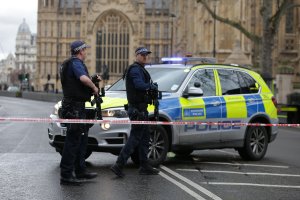Police investigating the deadly terrorist attack in central London are focusing closely on how the perpetrator became radicalized, as they battle to piece together his identity and connections.

Britain’s most senior counter-terror police officer, Mark Rowley, described the inquiry as “very large and fast-paced”, and announced two “significant arrests” Friday. Hundreds of officers had made contact with thousands of witnesses, he said.
Police have said that the attacker, 52-year-old British man Khalid Masood, had multiple aliases. Rowley said he was born Adrian Russell Ajao.
Asked about his possible conversion to Islam and subsequent radicalization, Rowley said: “Clearly that’s the main line of our investigation, is what led him to be radicalized, was it through influences in a community, influences from overseas, or through online propaganda.”
He appealed for anyone who knew Masood well or was aware of his recent movements to get in touch, as detectives probe his motivation, his preparation for the attack and his associates.
Nine people remain in custody and one woman has been released on bail, Rowley said.
Investigation continues
Police continue to search five addresses and another 16 searches have concluded.
Officers have seized 2,700 items, including “massive amounts” of computer data, and have had contact with 3,500 witnesses to the attack, many of them of different nationalities, Rowley said.
Echoing remarks by UK Prime Minister Theresa May, Rowley said Masood had “several years ago been a peripheral figure, he’s never been part of the mainstream intelligence picture of terrorism.”
He added, “Whilst there is still no evidence of further threats, you will understand our determination is to find out if either he acted totally alone, inspired perhaps by terrorist propaganda, or if others encouraged, supported or directed him.”
The attack left four people dead and injured at least 50 more, 31 of whom needed hospital treatment, Rowley said. Two people are in critical condition and another has life-threatening injuries.
Two police officers who were injured as the attacker plowed through crowds walking across Westminster Bridge also remain in hospital with “very significant” injuries, Rowley said.
The fourth victim, a 75-year-old man, died Thursday night after his life support was withdrawn at a hospital where he had been receiving treatment, according to London’s Metropolitan Police. He was named by Rowley as Leslie Rhodes, from Streatham in south London.
The other three who died were policeman Keith Palmer, stabbed as he protected Parliament, American tourist Kurt Cochran and college administrator Aysha Frade, a British citizen with Spanish roots.
The Romanian Foreign Ministry said a Romanian woman was in critical condition after undergoing complicated surgery for her injuries.
Arrests were made in London and Birmingham, while homes were also searched in Brighton and Carmarthenshire, in west Wales. Police said the addresses were “linked to the investigation” of Wednesday’s attack.
The number of armed officers remains at nearly double strength in London in the wake of the attack, Rowley said, while extra police officers are also on patrol elsewhere in the UK.
Who was the attacker?
Not a great deal is known about Masood, who was shot dead by a police firearms officer after he rammed a car into pedestrians on Westminster Bridge and stabbed an unarmed police officer outside parliament.
Born in Kent, Masood had been living in England’s West Midlands region — where Birmingham is located — and had previous convictions, but not for terrorism offenses, police said. His most recent conviction was in 2003 for possession of a knife.
Police have been searching an address in Birmingham’s Winson Green area where Masood is thought to have been living.
Neighbors told CNN that Masood had two or three children, aged around seven or eight, who would play with the other local children.
Masood always wore a robe and a cap and had a long beard, the neighbors said. A woman thought to be his wife was not seen interacting with neighbors, they said.
While a tweet from ISIS-affiliated news agency Amaq claimed Masood as a “soldier” of the terror group, inspired by its message, it provided no evidence of direct links between Masood and ISIS and did not name him.
More arrests
A 39-year-old woman was arrested at an address Thursday night in East London on suspicion of preparation of terrorist acts, police said. The woman, who has not been named, is being held under the Police and Criminal Evidence (PACE) act.
Six people — two women and four men, their ages ranging from 21 to 28 — were arrested at two addresses in Birmingham, a city in central England. The six were also held on suspicion of preparation of terrorist acts.
Another man, 58, was also arrested Friday morning at another address in Birmingham, and held on the same charge.
Vigils and defiance
A vigil was held in London Thursday in a show of solidarity and mourning for the victims.
“We come together as Londoners tonight to remember those who have lost their lives and all those affected by the horrific attack yesterday. But also to send a clear message, Londoners will never be cowed by terrorism,” London Mayor Sadiq Khan told the crowd.
A fundraising campaign for attack victims started by a Muslim man who witnessed the incident has already raised over $25,000, according to its website.
Muddassar Ahmed said he started the “Muslims United for London” campaign to show “we all stand with fellow Londoners during these difficult times and want to extend our support by raising funds to help with the immediate, short-term needs of the victims and their families.”





